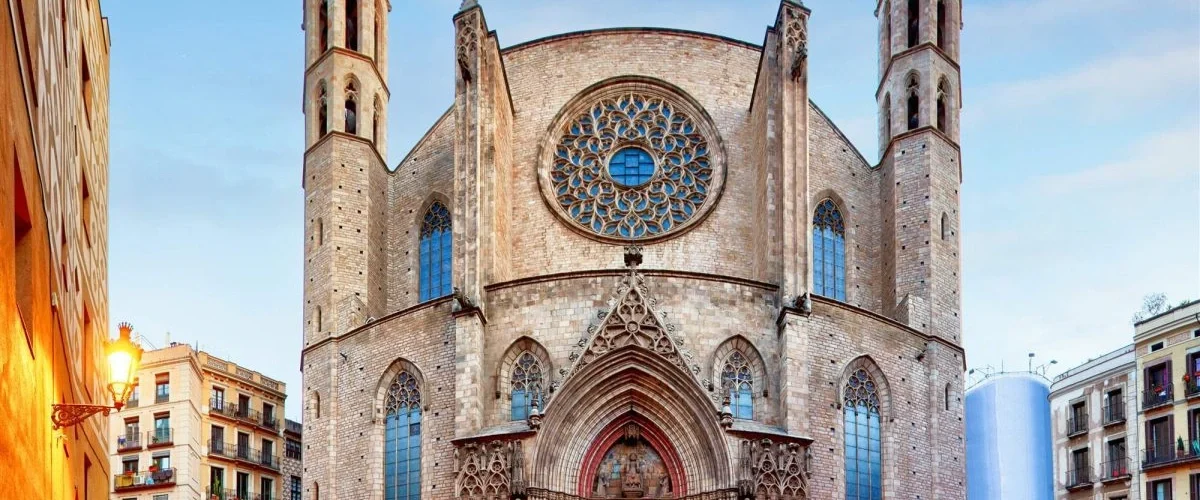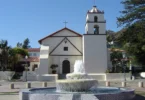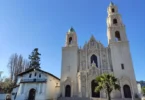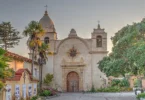Introduction
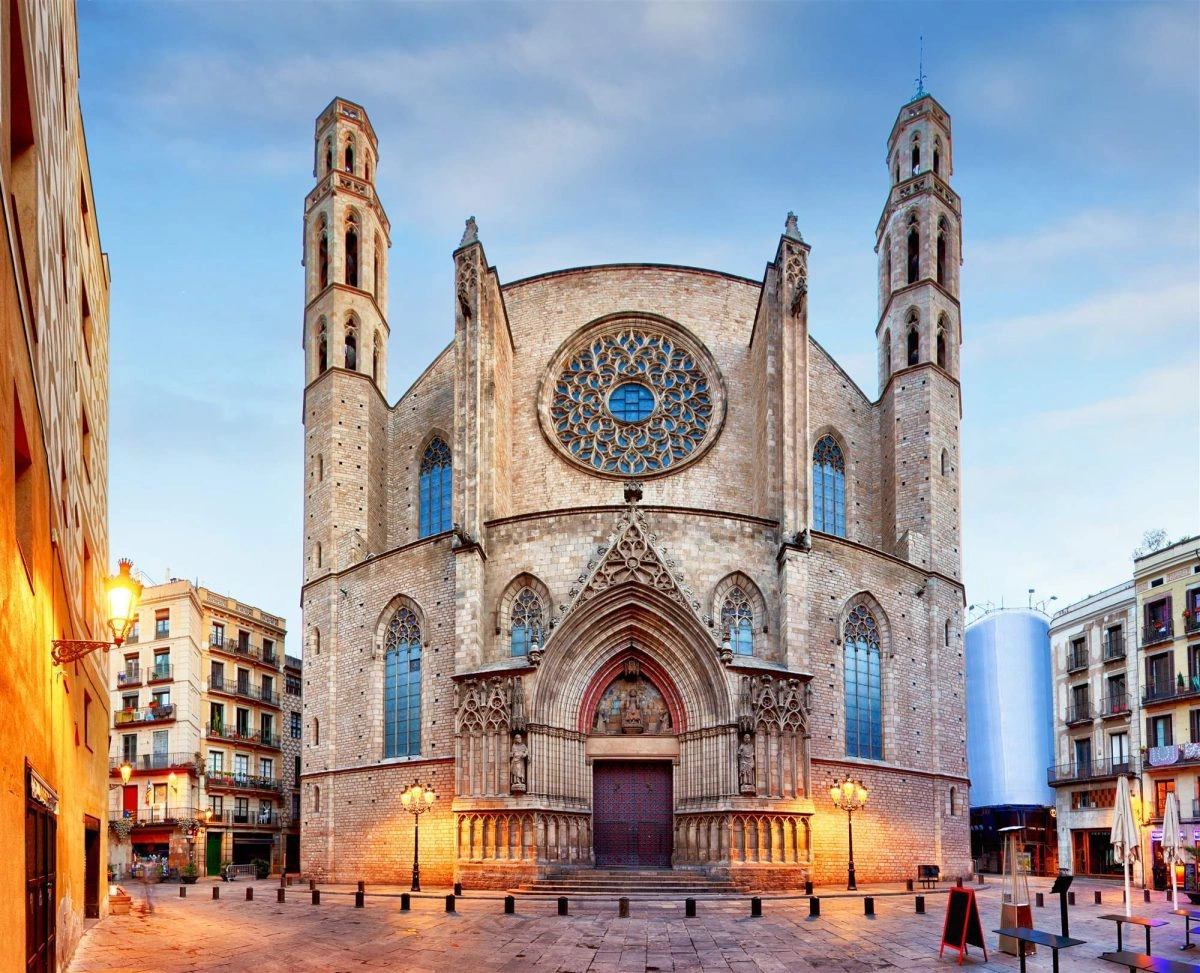
Santa Maria del Mar (Catalan pronunciation: [ˈsantə məˈɾi.ə ðəl ˈmaɾ], meaning “Saint Mary of the Sea”) is a historic church situated in the Ribera district of Barcelona, Catalonia, Spain. Constructed between 1329 and 1383, during the pinnacle of the Principality of Catalonia’s maritime and commercial dominance, this church stands as a striking symbol of the region’s medieval prosperity and cultural identity. It is widely regarded as one of the finest examples of Catalan Gothic architecture, distinguished by its exceptional purity and stylistic unity—qualities rarely seen in large-scale medieval buildings, which often reflect a mixture of influences accumulated over time.
Santa Maria del Mar serves as a minor basilica and holds great religious, architectural, and historical significance within the city of Barcelona. Its construction was closely tied to the vibrant mercantile community of the Ribera district, reflecting the deep connection between the church and the seafaring and trading population that thrived during the 14th century. Recognizing its cultural and historical importance, the church was officially declared a Site of Cultural Interest on June 3, 1931, ensuring its preservation as a treasured landmark in Catalonia’s heritage.
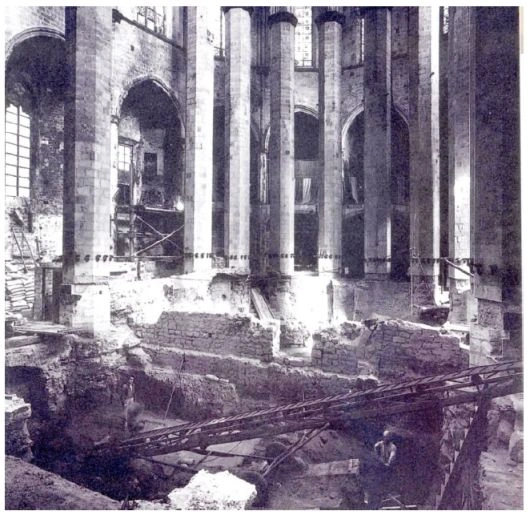
Early Origins and Foundation
The earliest known mention of a church dedicated to Santa Maria by the Sea dates back to the year 998. The current building, however, was initiated much later under the leadership of Bernat Llull, who became Archdean of Santa Maria in 1324. A distinctive aspect of Santa Maria del Mar’s construction was its strong backing by the common people rather than the nobility. The foundation stone was laid on March 25, 1329, by King Alfonso IV of Aragon, an event commemorated by a bilingual Latin and Catalan inscription on the façade facing the Fossar de les Moreres.
Construction and Community Involvement
The church was designed by architects Berenguer de Montagut and Ramon Despuig. Unique for its time, the construction was driven by the parishioners of the Ribera district, particularly the guilds of the area, including dockworkers known as bastaixos who carried massive stones from the royal quarry at Montjuïc and the nearby beaches to the construction site. This popular involvement contrasts sharply with the simultaneous construction of Barcelona Cathedral, which was closely associated with the monarchy and clergy. By 1350, the walls, side chapels, and façades were completed.
Challenges During Construction
In 1330, a fire broke out when scaffolding caught ablaze, damaging parts of the unfinished vault. Despite this setback, construction continued, and the final stone of the vault was laid on November 3, 1345. The first mass in the new church was held on August 15, 1346. However, in 1379, another fire caused damage to parts of the church, but the work was resumed, and the building was finally consecrated on August 15, 1384.
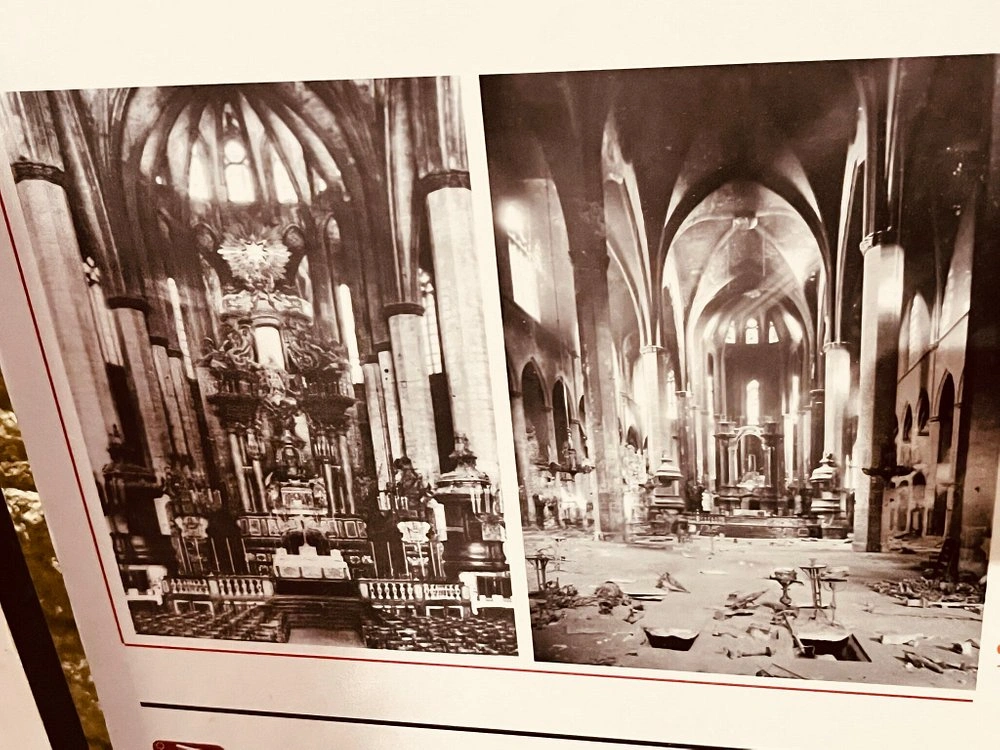
The 1428 Earthquake and the Rose Window
On February 2, 1428, a devastating earthquake struck Catalonia, causing casualties and severely damaging the church, including the destruction of its original rose window on the western façade. The replacement rose window, crafted in the Flamboyant Gothic style, was completed by 1459, and its stained glass was installed the following year, restoring one of the church’s most iconic features.
Later Architectural Additions
Over the centuries, Santa Maria del Mar evolved architecturally to reflect changing styles. In the late 17th century, Viceroy George of Hesse-Darmstadt commissioned the construction of a raised passageway linking the viceregal palace with the church. This passageway, which crossed the Fossar de les Moreres, was complemented by the Royal Tribune on the right side of the main altar. The church was also the site of a notable historical event on August 1, 1708, when Archduke Charles of Austria married Isabella Christine of Brunswick-Wolfenbüttel. In 1783, a new late-Baroque high altar was installed, designed by architect Deodat Casanovas and sculptor Salvador Gurrí. This altar featured twelve monolithic columns centered around an image of the Virgin Mary, adding to the church’s decorative richness.
Twentieth-Century Trials and Restoration
In 1923, Santa Maria del Mar was granted the status of a minor basilica by Pope Pius XI, acknowledging its religious importance. However, the church suffered severe damage during the Spanish Civil War in 1936, when anti-clerical rioters set fire to it. The blaze lasted eleven days, destroying many decorative elements, including the Baroque altar and numerous religious images. Despite the extensive damage, the structure itself survived. Following the war, restoration efforts began in 1938, although limited funding delayed the replacement of damaged stained-glass windows until the 1960s. A notable fundraising campaign included a contribution from FC Barcelona, which agreed to support the restoration in exchange for the inclusion of its coat of arms in one of the new stained-glass windows.
Historical Legacy and Preservation
Some modern studies suggest that the church stands on the site of an ancient Roman amphitheater or arena, adding to its layered historical significance. The CRAI Reserve Library of the University of Barcelona holds funds and archival materials related to Santa Maria del Mar, especially following the 1835 disentailment of convents, preserving a wealth of information about the church’s ownership and history.
Architecture of Basilica of Our Lady of the Sea, Barcelona, Spain

Architect : Berenguer de Montagut
Architectural style : Gothic architecture
Exterior of Santa Maria del Mar
From the outside, Santa Maria del Mar presents an imposing and austere appearance, which contrasts sharply with the lightness and spaciousness found within. The church is nestled tightly among the narrow, winding streets of the Ribera district in Barcelona, making it challenging to appreciate the building’s full scale except from two notable open spaces: the Fossar de les Moreres and the Plaça de Santa Maria. Both locations were historically used as burial grounds, providing a rare vantage point from which to admire the church’s west façade, dominated by a magnificent rose window. Flanking the main west entrance, niches house statues of Saint Peter and Saint Paul, while the tympanum above the door depicts the Saviour positioned between the Virgin Mary and Saint John. The church’s exterior is also notable for its two octagonal towers. The north-west tower was completed in 1496, but its southern counterpart was not finished until 1902, creating a distinctive asymmetry.

The overall external design emphasizes horizontal lines and flat wall surfaces, which give the building a massive, fortress-like solidity. Unlike the soaring verticality common in many European Gothic cathedrals, Santa Maria del Mar’s exterior intentionally downplays height. This effect is achieved through moldings, cornices, and galleries that accentuate the horizontal plane, forming a compact block without the deep wall recesses typical of French Gothic churches.
Two powerful buttresses frame the rose window and the west façade, visually supporting the expansive interior vault. The façade is divided into two distinct horizontal sections: the lower section centers on the portico entrance, while the upper section highlights the rose window, flanked by two smaller windows set between the buttresses and the octagonal towers.
The side walls of the church continue this theme of austerity, consisting largely of flat, undecorated surfaces punctuated by narrow windows corresponding to the interior chapels. These walls are supported by robust buttresses instead of the flying buttresses commonly found in northern Gothic cathedrals—an architectural element rarely used in Catalan Gothic style and completely absent here. Three clear horizontal divisions mark the elevation of the side walls. The lowest level contains relatively small windows that illuminate the interior chapels, spaced such that every three windows align with the space between two buttresses. Two side doors—the Hatters’ Door and the Moreras’ Door—provide additional access, along with a later addition known as the Borne Door, located near the apse.
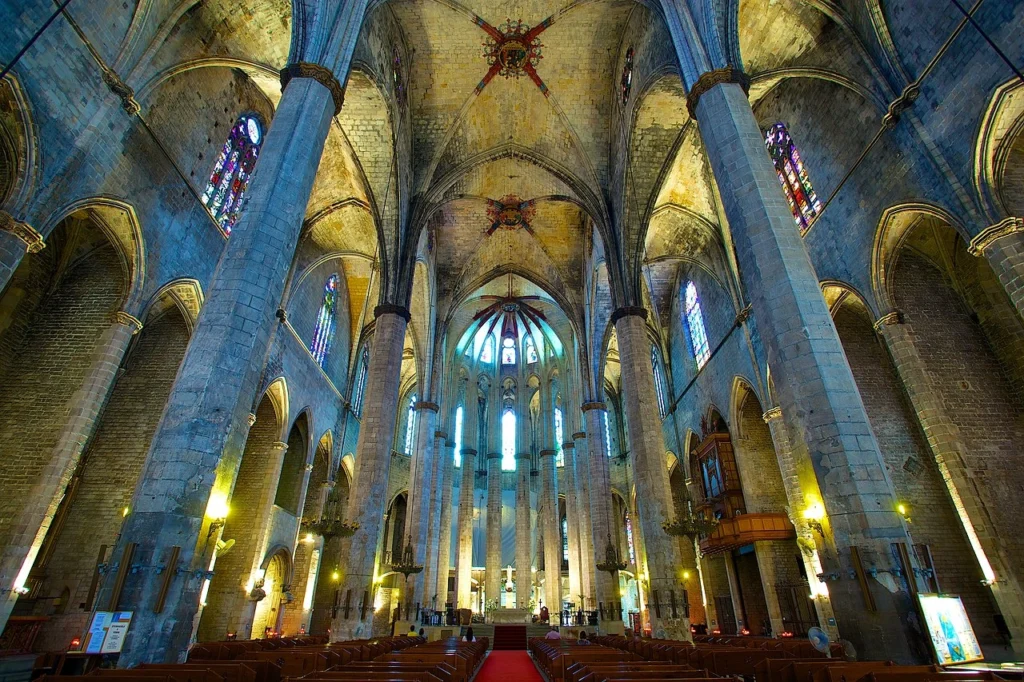
Interior of Santa Maria del Mar
In stark contrast to its fortress-like exterior, the interior of Santa Maria del Mar is characterized by exceptional lightness, spaciousness, and harmony. The church follows a basilica plan with three aisles of nearly equal height, lacking a transept and architectural divisions between the nave and presbytery, creating an open, unified space. The interior is supported by slender, octagonal columns that bear the simple yet elegant ribbed vaults overhead. The spacing between these columns is unusually wide—about 15 meters (approximately 43 feet)—the widest of any Gothic church in Europe, which enhances the sense of openness. The architect’s intention seems to have been to create a spatial experience akin to a single, vast nave rather than a segmented interior typical of French Gothic cathedrals. Daylight plays a starring role inside the church. The clerestory windows fill the upper walls with soft, even illumination. The central nave is lit by oculi (circular windows) located between the galleries above the side aisles, and these windows continue in the presbytery where they almost entirely fill the space between the columns, producing a radiant halo of light. The side aisles themselves are illuminated by relatively small windows, one per bay, which also contribute to lighting the central nave indirectly.
A striking feature of the interior is its austerity and simplicity: smooth, unadorned walls, clean octagonal columns without excessive decoration, and ribs that end at the capitals rather than continuing down to the floor. The arches of the central and side aisles spring from the same horizontal level (the impost line), creating an equalizing effect among the three naves and enhancing the spatial unity. This elegant design makes Santa Maria del Mar the most emblematic and refined example of Catalan Gothic architecture. The church’s scale and openness reflect the significance of the Ribera neighborhood as a prosperous mercantile and shipowning hub from the 13th century onward, necessitating a large parish church to replace the older Las Arenas Church. In the apse, the Chapel of the Blessed Sacrament, added in 1790 and designed by architect Francesc Vila, stands out. This chapel features notable paintings depicting The Last Supper and The Washing of the Feet by José Arrau Barba, adding a significant artistic element to the otherwise austere interior.
The Façades of Santa Maria del Mar

Santa Maria del Mar boasts three distinctive façades, each exemplifying the austere elegance of Catalan Gothic architecture. The main façade, facing the Plaça de Santa Maria, is the most visually striking, dominated by a magnificent 15th-century Flamboyant Gothic rose window. Flanking the central portal are statues of Saint Peter and Saint Paul, while the tympanum above features Christ the Saviour between the Virgin Mary and Saint John. The composition is symmetrical and monumental, with octagonal towers on either side and solid buttresses reinforcing the vertical and horizontal elements. The façade along Carrer de Santa Maria is notable for its monumental dimensions and gargoyles, which project from the buttresses, serving both as decorative elements and rain spouts. This side also offers views of the reverse side of the stained-glass windows, and the bare expanses of wall reflect the minimalist tendencies of Catalan Gothic. The third façade, on Passeig del Born, is simpler and includes the Borne Door, a later addition that connected the church directly to the heart of medieval Barcelona’s bustling commercial life. All three façades emphasize unadorned stone surfaces, structural clarity, and the symbolic weight of simplicity over ornamentation.
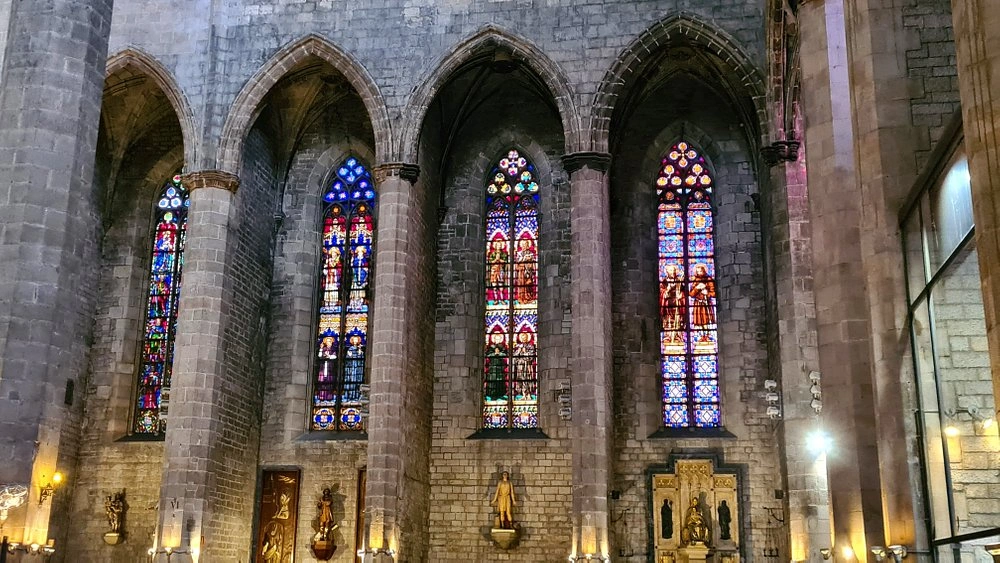
Interior Design and Proportional Harmony
The interior of Santa Maria del Mar is a masterclass in Catalan Gothic spatial design, emphasizing openness, unity, and light. The church features three high naves with no transept, creating a continuous space from entrance to altar. Tall octagonal columns, spaced unusually far apart (about 15 meters), support a ribbed vault and define the interior rhythm. This wide spacing gives the illusion of a single unified space, despite the tripartite structure. The proportions of the building are mathematically precise. As art historian Josep Bracons explains, the measurements are based on the medieval foot (33 cm): side chapels are 10 feet deep, side aisles are 20 feet wide, and the central nave spans 40 feet. The total width of the church is 100 medieval feet (33 meters), which also corresponds to the maximum height of the vaults. This exact proportional system results in a harmonious and balanced interior, where height and width are symmetrically aligned. The architecture avoids unnecessary decoration, allowing the stone and light to speak for themselves.
Destruction and Preservation
Despite its serene beauty today, Santa Maria del Mar has endured significant losses, especially during the Spanish Civil War. In 1936, during a wave of anticlerical violence, much of the church’s Baroque interior decoration, including altarpieces and sculptures, was destroyed by fire. While the flames gutted the rich ornamentation, the stone structure remained intact, and efforts to preserve and restore the basilica began shortly after the conflict. What remains today is a pared-down interior, marked by simplicity and sobriety, yet still rich in spiritual and architectural depth. Tombstones embedded in the floor, many related to seafarers and merchants, serve as lasting reminders of the city’s maritime heritage and the church’s close connection to the local community.
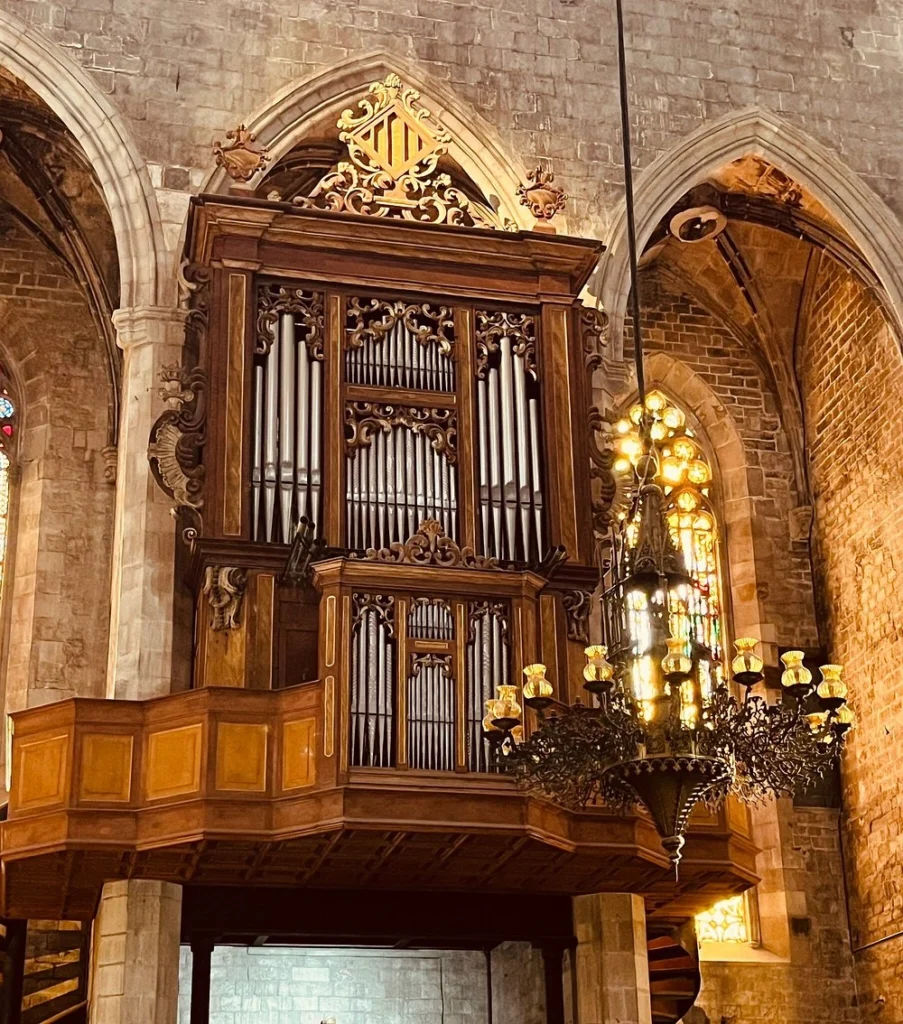
Santa Maria del Mar in Fiction and Popular Culture
The enduring cultural significance of Santa Maria del Mar extends far beyond architecture and history—it is also a central character in literature and film. The basilica gained international fame through Ildefonso Falcones’ historical novel The Cathedral of the Sea, which tells the story of a humble stone carrier who helps build the church. This best-selling book, with over six million copies sold, has been translated into dozens of languages and adapted into a popular Netflix series in 2019. Falcones continued the story in his sequel, The Heirs of the Earth. The church also appears in other works of fiction, such as Carlos Ruiz Zafón’s atmospheric novel The Angel’s Game and Àfrica Ragel’s young adult story Els savis de l’Acadèmia dels Desconfiats. These references in literature and media underscore the church’s deep resonance with Catalan identity and its symbolic value as a monument to perseverance, community, and devotion.
Feast Day
Feast Day : 15 August
The Basílica de Santa Maria del Mar in Barcelona, dedicated to Saint Mary, celebrates its feast day on August 15, the Assumption of the Blessed Virgin Mary. This date also marks the church’s consecration in 1384 and is a major Marian celebration in the Catholic tradition.
Church Mass Timing
Monday to Saturday : 7:30 PM
Sunday : 12:00 PM , 7:30 PM
Church Opening Time:
Monday to Sunday : 10:00 AM , 8:30 PM
Contact Info
Address : Basilica of Our Lady of the Sea
Plaça de Santa Maria, 1, Ciutat Vella, 08003 Barcelona, Spain.
Phone : +34 933 10 23 90
Accommodations
Connectivities
Airway
Basilica of Our Lady of the Sea, Barcelona, Spain, to Josep Tarradellas Barcelona-El Prat Airport (BCN), distance 17 min (14.1 km) via B-10.
Railway
Basilica of Our Lady of the Sea, Barcelona, Spain, to Estació de França Avinguda del Marquès de l’Argentera,, distance between 3 min (450.0 m) via Av. del Marquès de l’Argentera.

